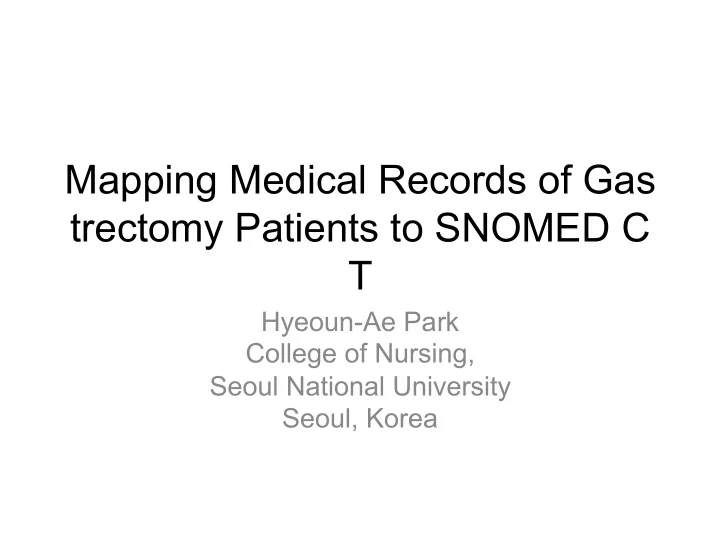

Mapping Medical Records of Gas trectomy Patients to SNOMED C T Hyeoun-Ae Park College of Nursing, Seoul National University Seoul, Korea
Background • Electronic medical records (EMR) improves the ac cessibility of medical information and contribute to the readability and completeness of information, al lowing users to search for and use information wit h more ease through greater integration of informa tion. • Structured data entry is one way of collecting more reliable ad more complete data in electronic medi cal records. • Thus, the design of the structured data input interf ace plays a major role in a successful implementat ion of electronic medical records
Background (Cont’d) • An electronic nursing record system based o n ICNP was introduced in early 2003 in Korea and went so far as to use the data collected by this system in decision making and resear ch. • Unfortunately, a great deal of medical records , such as admission notes, progress notes, a nd summary discharge notes are still left in u nstructured free text format.
Purpose of the Study • To explore the ability of SNOMED CT to re present narrative statements of medical re cord of gastrectomy patients.
Methods – Data collection • Reviewed and collected narrative medical rec ords (admission notes, progress notes, and di scharge notes) of every three patients with g astrectomy per month from September 2009 until no more narrative statements with new meaning are found. • In total, 36 patients’ medical records with 281 hospitalized days were reviwed and collecte d.
Methods – Data analysis • Dissected narrative medical records into single-meaning state ments. • Extracted unique statements by removing semantically redund ant statements • Classified these narrative statements into three groups – Statements describing medical conditions of the patient (includin g signs/symptoms, lab results, diagnoses, and etc) – Statements describing procedures performed on the patients (inc luding medication, care plan, and etc.) – Other statements • Extracted concepts from the unique statements describing me dical conditions of the patients and medical procedures perfor med on the patients
Methods - Mapping • Mapped extracted concepts to SNOMED CT (2009-07-31 international edition) concepts u sing CliniClue Xlore • Mapping of statements were classified into ful ly mapped, partially mapped and not mapped . • Mapping of concepts were classified into lexic ally mapped, semantically mapped, mapped t o a broader concept, mapped to a narrower c oncept, mapped to more than one concept, a nd not mapped
Method - Validation • The results of extracting concepts from statements and mapping them to SNOMED CT concepts wer e verified by a group of domain experts. • The experts consisted of a surgeon who performs gastrectomies, a nurse with a Ph.D degree in nursi ng informatics with experience in SNOMED CT ma pping research, a doctoral student with experience in SNOMED CT and nursing informatics research, and a student with a master’s degree who maintai ns electronic medical records using the SNOMED CT.
Result • In total, 4,717 single and 858 unique stateme nts were collected from 281 days’ of medical records of 36 patients documented by 19 doc tors • Out of 858 unique statements, 431 (50.2%) w ere statements describing patients’ conditions , 246 (28.7%) describing procedures provide d to patients and 181 (21.7%) describing othe r than patients’ conditions and procedures.
Result (Cont’d) Table 1. Mapping of Statements by SNOMED CT Patient conditions ! Treatments given ! Total ! ! ! ! ! ! No. of No. of No. of No. of No. of No. of total st unique st total st unique s total st unique st ! ! atements atements atements tatements atements atements (%) ! (%) ! (%) ! (%) ! (%) ! (%) ! Fully- 3071 396 669 183 3740 579 mapped ! (96.8) ! (91.9) ! (80.0) ! (74.4) ! (93.3) ! (85.5) ! ! 101 35 167 63 268 98 Partially- m apped ! ! (3.2) ! (8.1) ! (20.0) ! (25.6) ! (6.7) ! (14.5) ! 3172 431 836 246 4008 677 Total ! ! (100.0) ! (100.0) ! (100.0) ! (100.0) ! (100.0) ! (100.0) !
Result (Cont’d) Table 2. Mapping of Concepts by SNOMED CT No. of No. of ! ! unique concept(%) ! total concept(%) ! ! ! Mapped to SNOMED CT 660(93.6) ! 9135(97.0) ! Lexically mapped ! 213(30.2) ! 1611(17.1) ! ! Semantically mapped ! 152(21.5) ! 4390(46.6) ! ! Mapped to a broader concept ! ! 97(13.8) ! 1204(12.8) ! Mapped to a narrower concept ! 8( 1.1) ! 53( 0.6) ! ! Mapped to more than one 190(27.0) ! 1877(19.9) ! concept ! ! Not mapped to SNOMED CT ! 45( 6.4) ! 280( 3.0) ! ! Total ! ! 705(100.0) ! 9415(100.0) !
Discussion • Higher mapping rate for narrative statements desc ribing patients conditions than narrative statement s describing procedures (<- most procedures were already coded and documented in a structured wa y) => value of structured data entry for collecting in formation on patient conditions • Lack of concept in SNOMED CT (ex, GOT(yes) an d GPT(no)) • Pre-coordination versus post-coordination (ex, no sputum versus no dsypnea)
Conclusion • Almost 85% of narrative statements and 83% of concepts describing patient conditions an d procedures were fully mapped to SNOMED CT. (higher than maping rate of narrative nur sing statements ranging 47.6% to 79.2%) • This high mapping rate implies that physician s’ narrative medical records can be structured using SNOMED CT and used for structured data entry in electronic medical record syste m
Recommend
More recommend